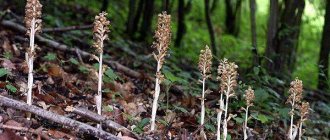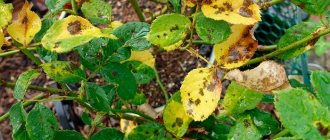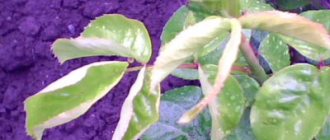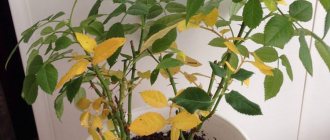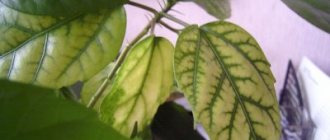Description
In a rose, the structure of the bush can be narrow pyramidal and spreading. Its height reaches from 30 to 200 cm. Roses are distinguished by two types of perennial branches - uterine, or main, and branches with completed growth. The length of the peduncle of a garden rose is from 10 to 80 cm.
Rose flowers amaze with their variety and quantity. Their sizes range from 1.7 cm to 18.5 cm, and the number on a bush is from 5 to 128. The structure of the rose, the shape of the flower, the smell and color are also varied. For example, a variety of rose with a green tint was recently developed. Today there are more than 30 thousand varieties of roses.
About agriculture—-> Articles and books related to crop production. Articles No. 1-50—-> Articles and books related to crop production. Articles No. 51-100A very detailed article about the structure of roses.
Plant structure.
Flower structure.
Rootstocks
Modern varieties of roses are usually not grown on their own roots (the so-called own-rooted roses), but are grafted onto wild roses (rose hips) or varieties obtained from them.
The following plants are used as rootstocks: Rosa “Laxa” The most popular rootstock is reliable, tolerates replanting well, produces almost no shoots and has almost no thorns, which is convenient for grafting.
Rosa canina (dog rose) Produces the hardiest roses. Some varieties that grow well in heavy soils are used as rootstocks. Not particularly popular due to the abundance of tops.
Rosa multiflora (multiflora rose) Produces strong plants. Popular in the USA, little widespread in the UK. The grafting does not take root well, and the resulting plant may not last long.
Rosa rugosa (wrinkled rose) Sometimes used as a rootstock for standard roses. It is not recommended to graft bush roses onto it, since it produces a lot of tops and does not grow well in heavy soils.
GROWING METHODS
Roses are cultivated as ground cover plants or vines, they form a bush or form a standard tree. Hybrid tea roses, patio roses, miniature roses, floribunda roses and shrub roses grow in bush form.
TYPES OF FLOWERS
Number of petals
Coloring
Petal shape
Many varieties of roses have flat petals, but some hybrid tea and floribunda roses have recurved petals. Some varieties have petals with a wavy edge; the FJ Grootendorst variety has serrated petals along the edge, like carnation flowers
Flower shape
TYPES OF LEAVES
Leaf surface
A typical rose leaf consists of five to seven smooth leaflets, the surface of which can reflect light to varying degrees. Some varieties of roses have leaves that shine so much that they look like they have been rubbed with oil, while the leaves of other varieties are almost dull. Besides these two cases, there are many intermediate ones. Therefore, it is possible to distinguish between highly shiny, shiny and matte smooth leaves. Not all roses have leaves with five or seven leaflets - some, such as the Canary Bird variety, have beautiful feathery leaves with more numerous leaflets. The surface of the leaf is also not always smooth - wrinkled rose leaves have deep grooves.
Leaf color
Almost all mature rose leaves are green, ranging from dull light green on Fred Loads to dark green on Felicia. The pictures below show the three main different types of leaves - light green, green and dark green. Some varieties of roses have bronzed foliage, with a characteristic copper tint.
There are exceptions to this rule. Shrub roses often have young leaves with a purple or scarlet tint, and some roses, such as Rosa rubrifolia and Buff Beauty, retain their red coloring on mature leaves. On the other hand, white rose hybrids have bluish-green leaves. Some roses, such as the rugosa rose, have exceptionally beautiful autumn leaves.
FLOWERING PERIOD
Reblooming roses experience two or more waves of flowering during the season.
Modern varieties of roses tend to bloom at intervals several times during the summer and even in the fall. It is this property that explains the enduring popularity of hybrid tea roses and floribunda roses. Re-blooming, or, as they are also called, long-blooming, or remontant, roses can also bloom in the intervals between the main flowering periods. In single-blooming roses, one wave of flowering usually lasts several weeks. Individual flowers may appear on them in the fall, but this is not considered a repeat bloom. Most often, these roses bloom in the summer, in June-July, although some varieties of shrub and climbing roses bloom in late spring, early summer or late summer.
FRUIT
After the flowers fade, some shrub roses bear bright, fleshy fruits. Fans are well aware of the red bottle-shaped fruits of the Moyes rose (Rosa moyesii) and the large, tomato-like fruits of the Frau Dagmar Hartopp variety. Fruits of other varieties come in a wide variety of shapes and colors.
FRAGRANCE
The aroma is one of the advantages of roses.
In the descriptions of rose varieties (pp. 12-90) for each variety it is indicated how strong the aroma of its flowers is, and the following grades are accepted: no aroma, slightly fragrant, fragrant and very fragrant. It should be remembered, however, that the evaluation of odor depends on many conditions, including - • Personal taste: Some prefer heavy, intoxicating aromas, others like spicy or fruity aromas. • Individual sensitivity: There are people who have difficulty distinguishing odors, but usually this deficiency, unlike deafness or visual impairment, does not manifest itself in any way. • Age of the flower: The flowers of some varieties of roses smell stronger at the beginning of flowering, others - when they fully bloom. • Weather: Flowers smell stronger in warm, humid weather.
The aroma is usually characteristic of the flowers, although some varieties of roses have fragrant leaves - see the description of the Lady Penzance variety.
Based on the book by Dr. D.G. Hessayon. "All about roses." [email protected]
Classification
Roses are divided into three main groups:
- varietal;
- garden (ground cover and flower beds);
- wild ones, as well as their hybrids.
It is worth noting that this is not a universal classification, and there are various variations. Among the types of roses that are used in landscaping, there is a division into climbing, varietal and deciduous varieties. Wild and their hybrids often include climbing and park varieties. The most common are deciduous and shrubby groups. They are distinguished by their long flowering time and high growth rate.
Corrugated paper rose with candy
You will need: a box of chocolates - they should be in foil, corrugated paper in your favorite colors, scissors, gold thread, bamboo skewers, satin ribbon, decorative accessories.
Master Class
- Take corrugated paper and cut it into squares.
- Make small cuts on each square.
- Take the petals and wrap the candy to form a rose.
- Secure the rose using gold thread.
- Repeat these steps with all the candies.
- Attach flowers to skewers.
- Form a bouquet and tie with a satin ribbon.
- Decorate to your taste with decorative fittings.
I recommend watching the video master class!
Root system
The root system of a rose bush is taproot. In the case of vegetative propagation - fibrous. The skeleton is the largest of all the roots of the system, about 3 cm in diameter. The underground part of the rose is connected to the above-ground part by the root collar. As for the structure of the rose in terms of its root system, it is also diverse. In particular, the neck can reach sizes from 3 to 15 cm. This depends on the planting depth. The root collar is a very important part of the plant, and when planting it is necessary to take into account its location in the seedling.
Lobes are small adventitious roots that are located at the ends of the lateral roots. With their help, the bushes receive all the nutrients necessary for development and growth, as well as water.
Which roses don't run wild
Roses are:
- vaccinated;
- unvaccinated.
Grafted plants
Dutch roses - varieties, growing features
The peculiarity of grafted shrubs is that they consist of two types. The upper part of them belongs to a variety that is not strong enough to grow with its root system. Therefore, you need another plant with strong and hardy roots - this is the lower part of the grafted bush.
On a note! If the top part dies, the plant does not inherit the flowering properties.
To determine whether a flower is grafted or not, you need to look at its lower part. The grafting site looks like a thickened ring protruding from the stem.
Ungrafted plants
They are grown on their roots. They have a higher risk of getting sick, and they will only get stronger when they grow up. Although some varieties will always be poorly adapted. The stem of ungrafted crops looks smooth, without protrusions.
You can determine by the leaves of a rose whether it is wild or not, but this is not a 100% way. You should always pay attention to other signs, because cultivated rose bushes with different numbers of leaves are now widespread.
Structure of a rose leaf
They are attached to the stem using special nodes. In the same way, the leaves are connected to the side shoots. The standard one has from 5 to 7 leaves, which are attached to one petiole. Sometimes their number reaches 15 pieces. Each type of rose has different leaves. They differ in size, shape, texture and color.
Almost all types of mature roses have green leaves, ranging from light to dark shades. However, there are bronze or purple colored varieties that produce a coppery tint. The leaf plate reflects light in different ways. For example, in some varieties they shine so much that it seems as if they have been rubbed with oil. Other varieties have an almost matte finish. There are also intermediate options. Thus, they are divided into:
- matte;
- leathery;
- semi-matte;
- glossy;
- semi-gloss.
The leaf blade is smooth or with pronounced convex veins. Typically, its size in wild rose species is smaller than in cultivated ones. The edges of the leaf are divided into serrated and solid. The matte texture is most often characteristic of wild varieties, and the glossy texture is characteristic of cultivated varieties.
Classification of roses by origin (with photo)
Dividing rose varieties into groups, the number of which is almost impossible to count, makes practical sense. About 40,000 varieties of roses, bred over the last two centuries, are grouped according to their characteristic characteristics. The classification of plants according to the origin of roses has developed historically.
For example, there are Gallic rose hybrids, Portland roses and multiflora rose hybrids.
These photos show roses representing different groups in the classification:
For an amateur gardener, this order means nothing. Therefore, a classification system has been developed for modern roses, based on the principles of application of each group in the garden. When a hobbyist hears the names "miniature rose" or "climbing rose", he can imagine what we are talking about. It is worth remembering that such a division is very conditional. This means that a climbing rose with an elastic stem can turn into a ground cover if it is not tied up, and a wildly growing climbing rose can become a bush as a result of improper pruning and climate influences. There are no strict limits. And sometimes the results of external influences are completely unpredictable.
Wrinkled rose or wrinkled rose hip - Rosa rugosa Thunb
Rose wrinkled
Rosa rugosa is a shrub up to 2 m high. The branches are thick, erect, and bear numerous strong straight or slightly curved spines with a wide base and small needle-like spines and bristles. The shoots are densely pubescent.
Leaves of 5-9 rounded or elliptical leaflets with a serrated margin. The petiole is pubescent with wide, white-haired stipules below. The leaves are bare, glossy and distinctly wrinkled on top, as reflected in the specific name; the leaves below are profusely pubescent and often even felt-like. The flowers are large, up to 6-8 cm in diameter, carmine-pink and very fragrant, collected in few-flowered inflorescences or, less often, arranged singly. The wrinkled rose blooms from June to late autumn.
The fruits are fleshy, spherical or somewhat flattened-spherical, up to 3 cm in diameter, bright red or dark orange. Sepals are erect. The fruits of the rugose rose begin to ripen in mid-summer.
The range is Primorye, southern Kamchatka, Sakhalin, the Kuril and Shantar Islands, and outside Russia - China, Korea and Japan. Wrinkled rose grows on sandy and sandy-pebble sea coasts. Often forms thickets, so-called coastal rose gardens.
The wrinkled rose in its decorative qualities is not inferior to cultivated varietal roses, therefore it is widely grown in our country in cities, towns and on personal plots. In addition, rugosa rose is resistant to low winter temperatures, diseases and pests that often attack cultivated varieties. At the same time, it often runs wild. Its fruits are rich in vitamin C and carotene, and therefore are often prepared for the winter, collected for jam and jelly. Rosa rugosa flowers contain essential oils.
The structure of rose fruits
At the end of flowering, some varieties of roses open their petals and expose their fruits. This mainly occurs in wild ones. In reality, rose fruits are seed pods. They crown both the leaf growths and the places where the sepals were located.
Rose fruits are brightly colored, however, depending on the variety, they differ in color, shade, size, and shape. The color is usually bright red. But there are varieties in which it varies from pale yellow to black-brown.
The shape of the rose fruit is most often round or oval. The bottle-shaped one is also found. The sizes vary, from 0.5 cm to 2.5 cm. The fruits, in addition to their direct natural purpose, are used by humans in cosmetology and medicine.
Signs indicating the degeneration of a rose into a rose hip
The degeneration of a plant is not easy to notice because it is a gradual process. It is easiest to distinguish mature crops from each other, but this is more difficult to do with young bushes.
The leaves of a rose are drying up - what could be the reasons?
What parts of plants you need to pay attention to:
- Stems. The rose hips are green, and the roses are red.
- Spikes. In rose hips they are small and located close to each other, while in roses they grow infrequently and are larger in size.
- Leaves. The leaves of the rose are smooth and shiny. Rosehip leaves are rough and covered with villi. This makes them fluffy to the touch.
Why does rebirth occur?
Reasons why a rose degenerates into a rose hip:
- Buds could remain on the rootstock. Because of this, in addition to rose shoots, rose hip shoots also develop. Over time, wild bush can even choke out rose bushes.
- If a rose seedling was planted close to the surface, then the bush grows weak and is much inferior to rose hips.
- If a rose bush is sick with something, this makes it more vulnerable, including to the rootstock, which has an increased chance of suppressing the sprouts of the cultivated plant.
Note! If you fail to distinguish a rose hip from a rose bush in time and do nothing, it will die.
What to do in case of degeneration
There are methods to help deal with rose hips.
Trimming
If one procedure is not enough, subsequent ones will be required. The cutting is done like this:
- First they get to the roots by digging out the soil.
- Then they look for the very place where the rose was grafted onto the rosehip.
- Carefully cut off the rosehip shoots.
- All cut areas are lubricated with iodine (if desired, they can be treated with another product).
Important! You need to cut the rosehip shoots carefully so that there are no stumps left.
Plant pruning
How to prevent degeneration
The same pruning is used as a preventive measure. It must be carried out regardless of whether rebirth occurs or not. Every summer it is necessary to remove those parts of the plants that dry out, begin to wither or turn black.
You need to cut:
- wild shoots growing straight from the ground;
- flowers that have already bloomed;
- weak, dry and fast-growing shoots;
- stems on which a white or brown coating has appeared.
Important! Cultivated plants should always be planted deeper into the soil.
Perhaps you should completely abandon the idea of \u200b\u200bgrowing roses on the plot. Garden crops are more difficult to manage and require more effort. Sometimes it’s easier to deal with indoor roses growing in a vase or pot, where there is nowhere for rose hips to appear. But you still need to remember about the likelihood of diseases and pests, and also that the sun, for example, can cause the plant to burn and become covered with burns.
Flowers
The structure of rose flowers has a complex structure. They are multi-flowered - from 5 or more on one bush, few-flowered - from 2 to 3, and single-flowered. They can be located at the top or along the entire length of the bush. They also differ in shape:
- cone-shaped;
- spherical;
- square;
- pompon;
- boat;
- rosette-shaped.
It should be noted that as the flower opens, its shape changes greatly. The color of the bud now is simply amazing. A huge number of colors and shades have been produced. Color is divided into several types:
- plain;
- two-color;
- multi-colored;
- striped;
- mixed;
- colored (feathery pattern with a white eye at the base).
The petals, depending on the variety and type, also have different shapes, sizes, colors and aroma. Initially, nature created them as such to attract insects for the purpose of pollination. Currently, new varieties are being developed that have unusual colors, shapes and aroma only for better sale because of their extravagance. However, the rose always remains a beautiful flower, pleasing the eye with its beauty.
Small roses for a bouquet
No flower arrangement would seem complete without small elements. As a good addition to the bouquet, I would like to suggest making small roses. Everything is very simple.
- strip of pink paper measuring 15x4 cm;
- two green corrugated leaves, approximately 3 cm wide and 6 cm long;
- green tape;
- wire or skewer.
Take the pink strip and pinch the edge, starting at the overhanging corner, so that each time you fold, a new corner is created. Walk along the entire length.
Curl the rose with the curved side inward. Tighten with threads at the base, straighten the layers of paper. Glue the skewer with a glue gun and start wrapping it with tape. During the wrapping process, attach two leaves close to the flower itself.
If you make three roses on wire, you can connect them together into one composition and decorate the bouquet. Experiment with color, creating unique branches with charming roses!
I wish everyone a good mood and creative success! Subscribe to new articles on the site so you don't miss anything!
Rose is a beautiful noble flower. A bouquet of roses not only decorates, but also gives positive emotions and a good mood. In this article we will look at several options: how to make roses from corrugated paper with your own hands?
Viral diseases of roses
Young tissues are affected, mainly leaves, peduncles and flowers. The following types of viral diseases are common on roses:
- Rose mosaic virus (rose mosaic virus) is a disease accompanied by a wide variety of symptoms. Leaves may have chlorotic spots along the midrib or on one half of the leaf. The leaf blade and petiole may be deformed. Sick plants are often stunted and have underdeveloped flower buds and almost white flowers.
- Yellow mosaic virus (rose yellow mosaic virus) appears on leaves as small yellow mottled spots. Sometimes leaf curl is observed.
- Linear mottled mosaic (a strain of tobacco ringspot virus) infects leaves, forming pale green, yellow rings, wide stripes, and small specks on them.
- Streak disease (rose streak virus) causes brown rings on the leaves and lining of the veins of the leaf blades. Watery brown blurry spots often appear on young stems with this disease.
- Wilting (rose wilt virus) - manifests itself in the growth of young shoots with small narrow leaves. Leaves often curl and fall off. The shoots are underdeveloped and quickly die off at the end. The root system of diseased plants is loose and weak. The bushes die from general exhaustion.
Measures to combat viral diseases include careful culling and destruction of affected plants.
SAVE USEFUL INFORMATION ON YOUR FAVORITE SOCIAL NETWORK PAGE:
White coating on rose leaves
The velvety white coating may even seem beautiful at first glance, until you find out that it is fungal spores. Although sometimes the weightless cobwebs left by some insects can be confused with them.
— Powdery mildew leaves that same white velvety coating after prolonged rains;
— Spider mites hide among the branches and leaves and weave a whitish web around the rose;
— Small white spots remain when the leaves are attacked by the rose leafhopper. It is easy to notice visually from the reverse side along the veins.
Photo: cvetkoffandbuketoff.ru
Delicate rose made of corrugated paper
You will need: corrugated paper in pink, green and light pink colors, glue gun, wire, scissors, pencil.
Master Class
- Cut out a rectangle from pink crepe paper.
- Fold in half and round the edges.
- Stretch the top edge of the petal a little.
- Cut the stem of the bud and insert the wire inside.
- Cut a rectangle of pink crepe paper larger than the previous one.
- Cut 4 petals and curl them with a pencil.
- Assemble the rosette and insert the wire.
- Cut out a rectangle from light pink paper.
- Repeat points 2-7 of this master class.
- Make a stem out of green crepe paper.
- Form a flower by twisting the bud and wrapping it with wire.
Fungal disease burn of rose branches: photos and control measures
Fungal disease burns rose branches in the photo
Branch burn is a fungal disease in which reddish spots initially appear on the branches, later darkening in the middle; the red-brown border persists for quite a long time. As the spots grow, they ring the branches. Tissue sagging may form above the affected area. Diseased branches usually dry out at the end of summer.
The development of “burn” is facilitated by excess humidity under the winter shelter.
To avoid severe damage to roses, cover should be removed earlier in the spring. Sick and frozen branches must be pruned and burned in a timely manner.
As shown in the photo, when treating this disease of roses, plants need to be sprayed with preparations containing copper, as in the fight against rust:
Proper agricultural practices (timely application of fertilizers, loosening and watering) help reduce the severity of the disease. It is necessary to achieve good ripening of the wood until the end of the plant growing season.
For the winter, plants with already fallen leaves should be covered in dry weather if possible, so that increased humidity is not created under the cover. Before covering, unripe shoots with green leaves are removed, and the plants are sprayed with a 3% Bordeaux mixture or a 1.5% solution of ferrous sulfate.
How to determine the variety of rose
Sometimes, having bought and planted a rose on your plot, you may be faced with the fact that what grows in the end is not at all what the seller promised. It’s clear that all roses are beautiful, but I still want to know the specific variety of the one that grew. It should be noted right away that accurately determining the variety is a practically insoluble problem even for a very experienced gardener - there is too much variety. But it is quite possible to determine the species to which a rose belongs. First of all, determining the type of flower affects the choice of pruning method.
Download - How many leaves should a rose have Consultant R M Babariko
Garden World
Video comments
I will be waiting very much, I know he will not refuse you, SUCCESS.
Please tell me why my felt cherry tree hasn’t bear fruit for 5 years?
Here I have one like SUPER EX-ELSA, only white with 7 leaves, I thought that it had died out and become a rosehip, I wanted to dig it up or plant a good big rose. Thanks for the topic.
Good afternoon, Natalya, please tell me, I don’t know what type of rose, but it has seven leaves and it has burgundy leaves and the stem is it a rose hip or not.
Please tell me, this year the rose produced 7 leaves, I honestly didn’t pay attention to how many leaves there were last year, but there are no shoots below the graft. Based on your videos, is this normal?
Hello! I ordered roses, they came already with swollen buds in sawdust, I planted them in larger pots and buckets according to your videos, the leaves appear all shiny, only on one the leaves seem to be matte and not beautiful, what does this mean they sent me rose hips? Everyone had vaccinations and leaves These grow on cut branches and could this be a feature of the variety?
Good night Natalya. my new rose has two shoots... one to the side is green. weak. 5 leaves..second. stronger red. The first one was deleted. is it right ? I did the trimming as you said. Now they are blooming... magnificent.
Oh, girls, of course, Happy New Year to you, good health, fulfillment of your most cherished desires, more positivity, smiles and then everything will be excellent. I wanted to say a huge thank you for the work you’ve done, keep up the good work, and of course there are still wishes, I’d really like to see additional, new videos about pruning cherries with V.A. Sheremetyev, just not by foliage, but in early spring))) Well I was very interested in KGB and the Spanish bush, is it possible to prune any cherry or only on a dwarf rootstock, etc.
- ⇥ Autoplay
